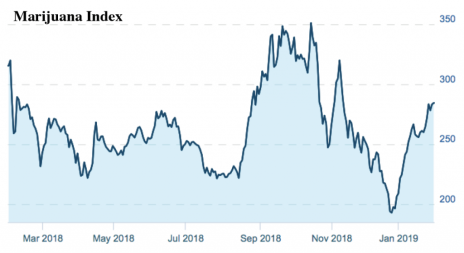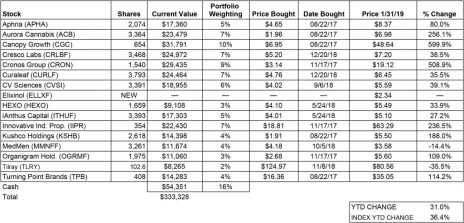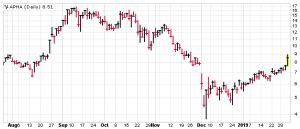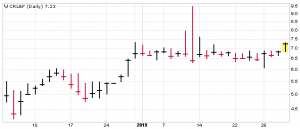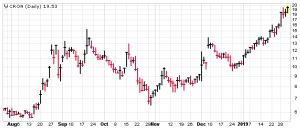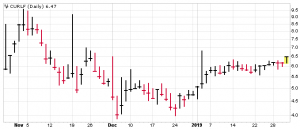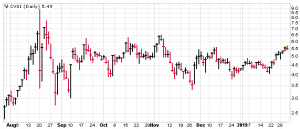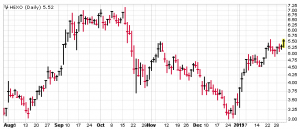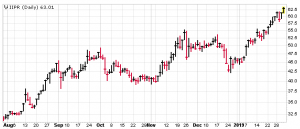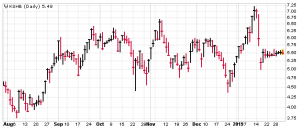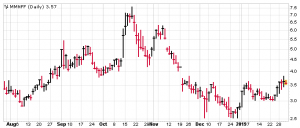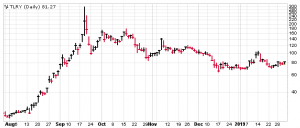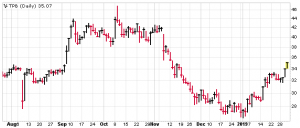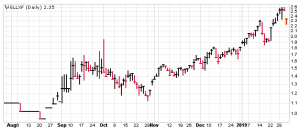The past month has been very profitable for investors in the sector, as stocks rallied off their December lows and climbed strongly through January, with several hitting new highs as I write. In general, I recommend that you enjoy the trend; the long-term prospects remain bright.
But short-term, there are opportunities for fine-tuning and risk reduction, and thus I have a few recommended changes in today’s issue, as well as one new addition, a company thriving in the booming CBD market.
Cabot Marijuana Investor 119
A Great Start to 2019
The marijuana industry is booming, at least when measured by revenues. Of the 15 stocks in our Marijuana Portfolio, the average growth rate of revenue in the latest reported quarter was 251%. If you take out the outliers (14% for Turning Point Brands and 1,888% for MedMen), the average growth rate was 205%.
Earnings, however, are still scarce, as the industry remains in grow-fast investment mode. And that’s fine as long as expectations among investors remain positive—which they do, judging from the action of the stocks as well as the Marijuana Index.
Since the market’s Christmas bottom, the sector has been sizzling, with the index advancing 36% YTD as of today. But it’s still well below the peak achieved the day before Canadian legalization last year—so upside potential remains substantial.
Of course, valuations are high, but that’s absolutely normal for fast-growing industries. Normally I don’t pay much attention to valuation when investing in fast-growing young companies. Amazon and Tesla were two huge winners in my other Cabot advisories that we owned for years before they even had earnings.
But I did do some work comparing the valuations of stocks in the marijuana sector in preparation for this issue, and the results confirmed my perception—that the big and famous companies in the industry, like Canopy Growth (CGC) and Cronos (CRON), which have the support of Big Alcohol and Big Tobacco, are substantially overvalued relative to their peers.
That’s one reason—but not the only one—that I’ll be taking partial profits in CRON and CGC tomorrow. But I won’t keep the cash; I’ll plow it right back into three smaller stocks. Details below.
Another trend I see in our stocks is a few management changes, as companies transition from their original entrepreneurial management teams to more experienced operational management teams. It’s a rare entrepreneur that can evolve as their company evolves, so this is a welcome development.
Also, there’s growing acceptance of cannabidiol (CBD) since the passage of the Farm Bill that legalized hemp nationwide, and the action in CBD stocks, in general, reflects this.
Lastly, I continue to see new IPOs (initial public offerings) of marijuana stocks, a sign of growing optimism. One reader recently asked if I would recommend marijuana IPOs, so he could benefit from the initial advance, and the answer is no, because IPOs are far from guaranteed to advance. In fact, I guarantee that as the current bull phase ends, IPOs will fall in value as demand for these stocks dries up.
Investing Strategy
1. Practice the number one rule of successful investing—diversify. Don’t just buy growers. Consider the companies in distribution, packaging, real estate, etc. I’m still looking for a banker to the industry.
2. Invest in sync with the trends of both the broad market and the marijuana sector. Both have been powerfully upward since late December.
3. Employ all the usual risk-reduction strategies. Diversify your buying over time, buy on dips, consider taking partial profits when stocks are extended (as we did the day before legalization in October), and cut losses short if you can’t tolerate holding big losses.
4. Always be aware of your risk level, and the fact that big moves in either direction are likely, especially in the lower-priced, more thinly-traded stocks.
5. Remember that this is a marathon, not a sprint; my goal is to get you invested in marijuana stocks that will be the leaders of the industry years from now, even decades, and then help you maximize your gains while minimizing your risk in the years to come.
WHAT TO DO NOW
The portfolio’s cash level is in the high teens, and I’d like to reduce that, ideally on a substantial correction by the sector. For now, that cash will sit. What I will do is sell a third of Canopy Growth (CGC) and Cronos (CRON) tomorrow, using the average price of the day, and reinvest the proceeds equally in Cresco Labs (CRLBF) and KushCo (KSHB) and new addition Elixinol (ELLXF). Details below.
CURRENT RECOMMENDATIONS
The portfolio was started with a hypothetical $100,000 on August 22, 2017.
Aphria (APHA)
Aphria used to be one of the big three growers in Canada, along with Canopy and Aurora, but now it’s fourth by market capitalization, brought down by the attack by short-sellers in early December while Cronos has been boosted by the big investment by Altria. In fact, the attack made the stock so cheap that Green Growth Brands threw together a hostile takeover offer—which the company is asking shareholders to ignore. In the meantime, the company announced its fiscal second-quarter results on January 11. Revenues were $21.7 million, up 63% from the prior quarter and 155% from the same quarter in 2017, so growth was good. Equally important, newly installed independent Chair of the Board of Directors Irwin Simon announced that after five years of leading the company, CEO Vic Neufeld and Co-founder Cole Cacciavillani will transition out of their executive roles in the coming months while the board transitions to a “globally-minded executive leadership team.”
The stock has doubled since its December low but remains well off its old high of 20, hit at the sector’s peak a year ago, reflecting investors’ uneasiness about management. Hold.
Aurora Cannabis (ACB)
With a market capitalization of roughly $7 billion, Aurora remains the No. 2 grower in Canada by market capitalization, and the most global of them all, with operations and interests in 18 countries thanks to a slew of acquisitions and deals. The company’s most recent quarter saw revenues of $57.6 million, up 260% from the year before, so growth is excellent and prospects are bright.
Like the other Canadian majors, however, ACB is expensive, and still well below its highs of January and October 2018. Yet I do think the stock’s recent pattern—climbing from 5 to 7 and then building a little base there—is constructive, so if you don’t own any, you could buy some here, ideally on a dip toward 6.
Canopy Growth (CGC)
With a market valuation of over $16 billion, Canopy remains the undisputed king of the marijuana industry, not least because of last year’s $4 billion contribution by Constellation Brands (STZ). But the story is about more than marijuana.
Earlier this month, the company was granted a license by New York State to process and produce hemp, and Canopy said it would invest between $100 million and $150 million in a New York hemp industrial park capable of producing tons of hemp extract on an annual basis. Senator Chuck Schumer, who was instrumental in the passage of the Farm Bill that made this possible, said he would “keep pushing to see industrial hemp become a true cash crop in the region.”
Canopy harvested over 4,500 square feet of industrial hemp from their cultivation site in Saskatchewan last year and is prepared to produce this same amount of hemp every year, and the addition of the New York operation has the potential to make the firm one of the leaders in the U.S. cannabis market.
Being the most famous name in the industry, Canopy gets the most attention from investors, especially institutions who find the sector’s smaller stocks too illiquid for their purposes. As a result its stock is far from a bargain; right now I calculate that it’s selling at roughly 60 times sales. But that doesn’t mean it can’t go up.
Since bottoming under 26 in late December, the stock has nearly doubled, and is now meeting resistance in the region of its September-October highs. I’ve already sold partial positions of CGC twice from this portfolio to take profits and reduce risk, and I’ve bought back in once—and now I’m going to sell some again. The stock is the largest component of the portfolio; it’s just doubled; and now it’s facing resistance at previous highs. The portfolio will sell one-third of its position.
Patient investors, particularly if it’s just a small part of your overall portfolio, can just hold, as the five-year prospects (and beyond) still look great.
Financial results for the quarter ended December 31 will be released after the markets close on February 14.
Cresco Labs (CRLBF)
Cresco is a U.S. multi-state retail operator, with operations in seven states (Illinois, Pennsylvania, Ohio, Nevada, Arizona, California and Massachusetts) and approvals pending in two more (New York and Maryland).
Cresco’s market capitalization is the lowest in the portfolio, at around $150 million, and the stock is thinly traded so it’s higher risk, but there are a couple of reasons that I think it’s a good buy here. First is valuation, which shows that CRLBF is trading at roughly three times sales. And second is the chart, which shows the stock coming public in early December, surging higher through most of the month, and then trading fairly tightly between 6.5 and 7.0 though the whole month of January. To me, that looks like a nice base, and a good place to buy, so I’m going to average up.
Cronos Group (CRON)
Cronos is the third-largest by market capitalization of the Canadian marijuana stocks, in part because last month, Altria Group announced that it would pay $1.9 billion to acquire 45% of the company—and this month the company announced its intention to accept the money.
Obviously, the maker of Marlboro cigarettes knows how to sell recreational drugs.
And the stock has performed superbly in recent months, blasting off from a low of 10 in late December, breaking out above its old high of 14 in mid-January and climbing to nearly 20 earlier this week. Its average trading volume even exceeds CGC’s!
But a gain of nearly 100% in a month is a bit much. Plus the stock is way overvalued, trading at more than 200 times sales. And, it’s the second-largest position in the portfolio. So for much the same reasons as CGC, I’m going to take profits, selling one-third of our position here to reduce risk and gain balance.
Patient investors, particularly if it’s just a small part of your overall portfolio, can just hold, as the five-year prospects (and beyond) still look great.
Curaleaf Holdings (CURLF)
Massachusetts-based Curaleaf is another U.S. multi-state retail operator, with 42 dispensaries, 12 cultivation sites and 10 processing sites, with a focus on highly populated, limited license states including Florida, Massachusetts, New Jersey and New York. And those East Coast states have the benefit of being farther from the black market that undercuts legal sales in California and other western states.
The company is the most highly valued of the U.S. multi-state operators, at $2.1 billion, so it’s not undiscovered. But management is aiming for sales of $400 million in 2019, so you might conclude, as some investors have, that it’s a decent value here based on the growth prospects.
In any case, the stock looks healthy here. After bottoming with the broad market in December at 4, the stock climbed to 6 in early January and has been trading at that level since, with a slight upward bias. If you don’t own it, you could buy here, trying to get on board on a dip toward 5.5.
CV Sciences (CVSI)
CV Sciences is not in the marijuana business; instead it’s a major seller of cannabidiol (CBD) oil, which is sold across the U.S. in health food stores, marijuana dispensaries and online under the brand Plus +CBD. The company also has a drug development division focused on developing and commercializing novel therapeutics utilizing synthetic CBD, aimed at treating smokeless tobacco use and addiction, an epidemic currently without effective treatment.
Interestingly, just this month, the company announced that Michael Mona, Jr., the company’s founder and former President and CEO, had retired from his position as an employee with the company. Mr. Mona had stepped down as the company’s President and CEO in mid-2018 and worked to ensure a seamless transition of these relationships. And now that those relationships are solidified and strong, Mr. Mona Jr. has tendered his resignation as a CV Sciences employee.
As for the stock, CVSI avoided the big selloff of the marijuana growers post-legalization, and its general pattern has been sideways since August, building a nice long base—with a burst of strength in recent days. If you don’t own it, you could buy here, ideally on a dip toward 4.5, where we see both the 25- and 50-day moving averages.
HEXO Corp. (HEXO)
HEXO is a small but fast-growing Canadian marijuana grower. In the latest quarter it reported revenues of $6.7 million, up 414% from the year before. Plus, the company has partnered with Molson Coors to put cannabis drinks on shelves in Canada as soon as they’re legal—probably this year.
And the good news for U.S. investors is that since January 23, the company has been trading on the NYSE American exchange under the ticker symbol “HEXO.” (Long-time readers remember when the company’s name was Hydropothecary and the symbol was HYYDF.)
As for the stock, it bounced strongly off its late-December bottom and surged higher in early January, getting an additional tailwind from the American exchange listing, but remains well below its old October highs at 7. Hold.
iAnthus Capital (ITHUF)
iAnthus owns and operates growers, processors and dispensaries in six U.S. states—with a strong focus on the East Coast. But instead of operating under one unifying national brand, it has different brands for different markets. In Massachusetts it’s Mayflower; in New York it’s Citiva; in Florida it’s GrowHealthy; in Colorado it’s Organix and The Green Solution; in Vermont it’s Grassroots Vermont; and in New Mexico it’s Reynold Greenleaf & Associates.
And just about now, iAnthus is expected to complete the acquisition of MPX Bioceutical, which will expand the company’s footprint to four additional states (Arizona, California, Maryland and Nevada), with 56 retail locations and 14 cultivation/processing facilities.
As for the stock, it bottomed with the market in late December at 3.5, and surged into January. But while its U.S. peers have generally been treading water since then, ITHUF has been motoring higher, in the process climbing above all its moving averages! If you don’t own it, try to buy on a pullback.
Innovative Industrial Properties (IIPR)
The best thing about IIPR today is that its stock has been hitting new highs since the middle of January—which is pretty impressive for a REIT (real estate investment trust). Of course, this is no ordinary REIT but a REIT focused on the cannabis industry and thus one of the “safer” legal ways to participate in America’s fastest-growing industry today.
Additionally, it’s one of the few companies in the portfolio with actual earnings. Thus, in this portfolio of young, volatile high-flyers, IIPR is a relative rock. It provides welcome diversification.
As of December 21, 2018, the company owned 11 properties located in Arizona, Colorado, Illinois, Maryland, Massachusetts, Michigan, Minnesota, New York and Pennsylvania, which were 100% leased and returning an average current yield on invested capital of approximately 15.3%. The stock’s yield is 2.3%.
As for the stock, which hit another new high today, it’s possible that it might keep climbing; REITs are a special class of investment in which I claim little expertise. On the other hand, technical analysis says it’s eventually going to pull back to its 50-day moving average (currently at 51) or further, so I don’t recommend buying now unless you’re an expert at short-term trading. Hold.
KushCo Holdings (KSHB)
KushCo is another component of the portfolio that’s here for diversification away from growers as much as anything. The company provides containers for the industry, as well as the veterinary medicine industry. It offers design and branding services to complement its containers (many of them child-proof). It offers a wide array of industrial gasses to cannabis processors, so they can turn harvested product into oils and more. It has an office in China to gain better control of its manufacturing relationships there, and it has a Toronto-based subsidiary to begin to tackle the Canadian market. Plus, all these operations are legal nationally.
For the fiscal first quarter ended November 30, Kush saw revenues grow 186% from the year before to $25.3 million. For fiscal 2019, the company is projecting revenues of $115 million, up 121% from fiscal 2018. So the fundamental prospects are great. Its relative valuation today is sort of middle-of-the-pack.
But KSHB has an interesting chart. It’s basically been stuck in a trading range between 4 and 7 over the past year, with a central tendency of 5.5.
Additionally, with a price-sales ratio of 5, the stock seems relatively undervalued compared to its peers. You could argue that that’s because eventually margins in this industry will be thinner, but it might also be true that if Kush maintains its status as the preferred supplier (one-stop shop) it will earn higher margins.
The portfolio is currently a bit light in the stock, and I do like the diversification KSHB offers, so I will buy more here.
MedMen (MMNFF)
MedMen is a major cannabis retailer in the U.S., with 19 facilities ranging from cultivation to retail in five key states: Arizona, California, Florida, Nevada and New York. All retail outlets operate under the MedMen name.
And business is good! Preliminary results for the quarter ended December 29 show revenue of $29.9 million, up 40% from the preceding quarter (and when acquisitions are complete, the number will jump to $49.5 million).
But management has made mistakes—above all a botched fund-raising deal in November that led to greater dilution and the exit of the CFO, who has since been replaced. The weight of that mistake is still visible in the stock’s chart.
Since bottoming in December, MMNFF bounced with the market, but remains well below its old high of 7.5. Hold.
Organigram (OGRMF)
Based in the province of New Brunswick, OrganiGram is the smallest of the Canadian growers in the portfolio by market capitalization, and possibly the lowest-cost producer in Canada, thanks to its cheap electricity and attention to automation.
The company is licensed to sell in all provinces except Quebec (which it is working diligently on), and it claims a leading market share position in the Maritime provinces of New Brunswick, Nova Scotia and Prince Edward Island.
As for the stock, it’s never been high profile, trading an average of 500,000 shares per day, but it certainly attracted attention earlier this week when the company announced its first-quarter results for fiscal 2019.
Revenues were $12.4 million, up 419% from the year before, while the cash cost of cultivation (a non-IFRS measure) was equal to $0.56/dried flower equivalent gram, down from $0.62 in the prior quarter.
The market loved the news, sending the stock shooting higher over the next three days, and now it’s nearly up to its October high of 6. If it can break through this level, great; the stock is not particularly expensive relative to its peers and I’d like to average up. But I don’t think it’s prudent right here facing the resistance of old highs.
Tilray (TLRY)
I think of Tilray as the “suits” who haven’t done much growing but have done a lot of deal-making with companies in related industries—so much that investors went ga-ga over the Nasdaq-listed stock last year, bidding it up to the ridiculous price of 300.
The stock has cooled since then, but the deals continue! In fact, just this month Tilray announced a joint venture with Labatt Brewery (a division of world leader AB InBev) to complement its recent distribution deal with Canada’s pharma giant Sandoz (a division of Swiss drug giant Novartis). The venture with Labatt will have Tilray and the beer-maker each contribute $50 million to create cannabis and CBD beverages for sale in Canada.
Prior to that, Tilray signed an agreement with Authentic Brands Group. ABG, based out of New York City, is known for its recognizable brands, including Juicy Couture and Nine West, and Tilray intends to leverage their portfolio in order to develop, market and distribute a brand of consumer cannabis products, including CBD.
In the latest quarter, revenues were $10.0 million, up 86% from the year before. That’s healthy growth, but not triple-digit like the Canadian growers who benefitted from the opening of the legal market in that country. The next quarterly results will be released around February 12.
As for the stock, it bottomed in December with the market and bounced strongly into January, but then was dragged down, apparently, by the selling of insiders taking advantage of the end of the lockup period. Now the stock is working to build a base around 80, but it’s still expensive by most yardsticks, so I’ll just hold patiently.
Turning Point Brands (TPB)
Turning Point is the old-school smokeless tobacco company that has been expanding into the cannabis and vaping and hemp and CBD markets, all while paying a dividend supported by its mature but declining tobacco business. Management is seasoned and has great experience in distribution across the U.S. Thus the stock is a great source of diversification in the portfolio, even though its revenue growth rate, 14% in the latest quarter, is the slowest.
As to the stock, it bottomed with the market at the end of December and has been trucking higher since, climbing above all its moving averages and hitting a new recovery high today. If you don’t own it, you could buy some here as the stock heads back to its old high of 44.
STOCKS ON WATCH
Charlotte’s Web Holdings (CWBHF)
Based in Colorado, Charlotte’s Web grows hemp and makes CBD—and claims to be the world’s leading brand by market share, with more than 3,000 retail locations. The stock came public in September, bottomed with the market in December and has climbed higher through January, achieving some record-high closes this week. I’d like to own the stock in the future, but as I explained in my update last week, I’m leery of buying the most famous (overvalued) stock in a sector, particularly when trading volume is light and downside potential is substantial; a correction to the 50-day moving average would bring a loss of 20%.
Elixinol Global (ELLXF)
Elixinol is a Colorado-based hemp grower and CBD retailer that is most notable for the way its stock (low priced and thinly traded) climbed to new highs in December—and kept climbing, hitting new highs even this week. Sellers finally stepped in today and I’m going to add it to the portfolio now, though if you’re looking for even lower risk you could wait until it meets its 50-day moving average, now at 1.85. BUY.
Origin House (ORHOF)
Previously known as CannaRoyalty, Origin House is California-centric platform of holdings via royalty agreements, equity interests, secured convertible debt, and licensing agreements. But it’s rather thinly traded and volatile; since bottoming in December, the stock is up almost 90%.
THE NEXT CABOT MARIJUANA INVESTOR WILL BE PUBLISHED February 28, 2019
Neither Cabot Wealth Network nor our employees are compensated by the companies we recommend. Sources of information are believed to be reliable, but are in no way guaranteed to be complete or without error. Recommendations, opinions or suggestions are given with the understanding that subscribers acting on the information assume all risks. © Cabot Wealth Network. Copying and/or electronic transmission of this report is a violation of U.S. copyright law. For the protection of our subscribers, if copyright laws are violated, the subscription will be terminated. To subscribe or for information on our privacy policy, call 978-745-5532, visit www.cabotwealth.com or write to support@cabotwealth.com.


